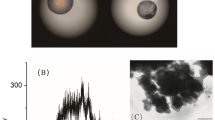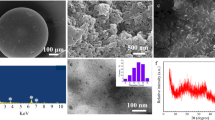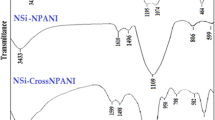Abstract
Immobilization of hydrous ferric oxide (HFO) particles inside solid hosts of porous structure is an important approach to improve their applicability in advanced water treatment such as arsenic and heavy metal removal. Here, we fabricated three polystyrene (PS)-based nano-HFOs and explored the effect of host pore structure on the surface chemistry of the immobilized HFOs. Potentiometric titration of the hybrids and surface complexation modeling of their adsorption towards arsenite and arsenate were performed to evaluate the surface chemistry variation of the loaded HFOs. Polymer hosts of higher surface area and narrower pore size would result in smaller particle size of HFOs and lower the value of the point of zero charge. Also, the site density (normalized by Fe mass) and the deprotonation constants of the loaded HFOs increased with the decreasing host pore size. Arsenite adsorption did not change the surface charge of the loaded HFOs, whereas arsenate adsorption accompanied more of the negative surface charges. Adsorption affinity of both arsenic species with three HFO hybrids were compared in terms of the intrinsic surface complexation constants optimized based on the adsorption edges. HFO loaded in polystyrene host of smaller pore size exhibits stronger affinity with arsenic species.
Similar content being viewed by others
References
Pierce ML, Moore CB. Adsorption of arsenite and arsenate on amorphous iron hydroxide. Water Res, 1982, 16: 1247–1253
Tuutijärvi T, Lu J, Sillanpää M, Chen, G. As(V) adsorption on maghemite nanoparticles. J Hazard Mater, 2009, 166: 1415–1420
Pena ME, Korfiatis GP, Patel M, Lippincott L, Meng X. Adsorption of As(V) and As(III) by nanocrystalline titanium dioxide. Water Res, 2005, 39: 2327–2337
Hristovski KD, Westerhoff PK, Crittenden JC, Olson LW. Arsenate removal by nanostructured ZrO2 spheres. Environ Sci Technol, 2008, 42: 3786–3790
Martinson CA, Reddy K. Adsorption of arsenic (III) and arsenic (V) by cupric oxide nanoparticles. J Colloid Interface Sci, 2009, 336: 406–411
Manning BA, Fendorf SE, Goldberg S. Surface structures and stability of arsenic(III) on goethite: spectroscopic evidence for inner-sphere complexes. Environ Sci Technol, 1998, 32: 2383–2388
Guo X, Du Y, Chen F, Park HS, Xie Y. Mechanism of removal of arsenic by bead cellulose loaded with iron oxyhydroxide (β-FeOOH): EXAFS study. J Colloid Interface Sci, 2007, 314: 427–433
Cumbal L, SenGupta AK. Arsenic removal using polymer-supported hydrated iron(III) oxide nanoparticles: role of Donnan membrane effect. Environ Sci Technol, 2005, 39: 6508–6515
Gupta V, Saini V, Jain N. Adsorption of As(III) from aqueous solutions by iron oxide-coated sand. J Colloid Interface Sci, 2005, 288: 55–60
Zeng L. A method for preparing silica-containing iron(III) oxide adsorbents for arsenic removal. Water Res, 2003, 37: 4351–4358
Jang M, Min SH, Kim TH, Park JK. Removal of arsenite and arsenate using hydrous ferric oxide incorporated into naturally occurring porous diatomite. Environ Sci Technol, 2006, 40: 1636–1643
Chen W, Parette R, Zou J, Cannon FS, Dempsey BA. Arsenic removal by iron-modified activated carbon. Water Res, 2007, 41: 1851–1858
Nguyen TV, Vigneswaran S, Ngo HH, Kandasamy J. Arsenic removal by iron oxide coated sponge: experimental performance and mathematical models. J Hazard Mater, 2010, 182: 723–729
Pan BC, Pan BJ, Xiao LL, Nie GZ, Wu J, Lv L, Zhang WM, Zheng SR. Adsorptive selenite removal from water using a nano-hydrated ferric oxides (HFOs)/polymer hybrid adsorbent. J Environ Monit, 2010, 12: 305–310
Pan BJ, Wu J, Pan BC, Lv L, Zhang WM, Xiao LL, Wang XS, Tao XC, Zheng SR. Development of polymer-based nanosized hydrated ferric oxides (HFOs) for enhanced phosphate removal from waste effluents. Water Res, 2009, 43: 4421–4429
Wang J, Zhang SJ, Pan BC, Zhang WM, Lv L. Hydrous ferric oxide-resin nanocomposites of tunable structure for arsenite removal: effect of the host pore structure. J Hazard Mater, 2011, 198: 241–246
Nie GZ, Pan BC, Zhang SJ, Pan BJ. Surface chemistry of nanosized hydrated ferric oxide encapsulated inside porous polymer: modeling and experimental studies. J Phys Chem C, 2013, 117: 6201–6209
Pan BC, Chen XQ, Zhang WM. A process to prepared a polymer-based hybrid sorbent for arsenic removal. Chinese Patent, ZL200510095177.5, 2005
Grossl PR, Eick M, Sparks DL, Goldberg S, Ainsworth CC. Arsenate and chromate retention mechanisms on goethite. 2. Kinetic evaluation using a pressure-jump relaxation technique. Environ Sci Technol, 1997, 31: 321–326
Goldberg S. Use of surface complexation models in soil chemical systems. Adv Agron, 1992, 47: 233–329
Gao Y, Mucci A. Acid base reactions, phosphate and arsenate complexation, and their competitive adsorption at the surface of goethite in 0.7 M NaCl solution. Geochim Cosmochim Acta, 2001, 65: 2361–2378
Herbelin AL, Westall JC. FITEQL, a computer program for determination of chemical equilibrium constants from experimental data. Version 4.0. Oregon State University, 1999
Zeng H, Singh A, Basak S, Ulrich KU, Sahu M, Biswas P, Catalano JG, Giammar DE. Nanoscale size effects on uranium(VI) adsorption to hematite. Environ Sci Technol, 2009, 43: 1373–1378
Sverjensky DA. Standard states for the activities of mineral surface sites and species. Geochim Cosmochim Acta, 2003, 67: 17–28
He YT, Wan J, Tokunaga T. Kinetic stability of hematite nanoparticles: the effect of particle sizes. J Nanopart Res, 2008, 10: 321–332
Vayssieres L. On the effect of nanoparticle size on water-oxide interfacial chemistry. J Phys Chem C, 2009, 113: 4733–4736
Dzombak DA, Morel FMM. Surface Complexation Modeling: Hydrous Ferric Oxide. New York: John Wiley & Sons Inc., 1990
Cristiano E, Hu YJ, Siegfried M, Kaplan D, Nitsche H. A comparison of point of zero charge measurement methodology. Clays Clay Miner, 2011, 59: 107–115
Stumm W, Morgan JJ. Aquatic Chemistry: Chemical Equilibria and Rates in Natural Waters. New York: John Wiley & Sons, 2012
Wilkie JA, Hering JG. Adsorption of arsenic onto hydrous ferric oxide: effects of adsorbate/adsorbent ratios and co-occurring solutes. Colloid Surface A, 1996, 107: 97–110
Jang JH, Dempsey BA. Coadsorption of arsenic(III) and arsenic(V) onto hydrous ferric oxide: effects on abiotic oxidation of arsenic(III), extraction efficiency, and model accuracy. Environ Sci Technol, 2008, 42: 2893–2898
Dixit S, Hering JG. Comparison of arsenic(V) and arsenic(III) sorption onto iron oxide minerals: implications for arsenic mobility. Environ Sci Technol, 2003, 37: 4182–4189
Madden AS, Hochella Jr MF, Luxton TP. Insights for size-dependent reactivity of hematite nanomineral surfaces through Cu2+ sorption. Geochim Cosmochim Acta, 2006, 70: 4095–4104
Author information
Authors and Affiliations
Corresponding author
Electronic supplementary material
Rights and permissions
About this article
Cite this article
Nie, G., Wang, J., Pan, B. et al. Surface chemistry of polymer-supported nano-hydrated ferric oxide for arsenic removal: effect of host pore structure. Sci. China Chem. 58, 722–730 (2015). https://doi.org/10.1007/s11426-014-5285-6
Received:
Accepted:
Published:
Issue Date:
DOI: https://doi.org/10.1007/s11426-014-5285-6




